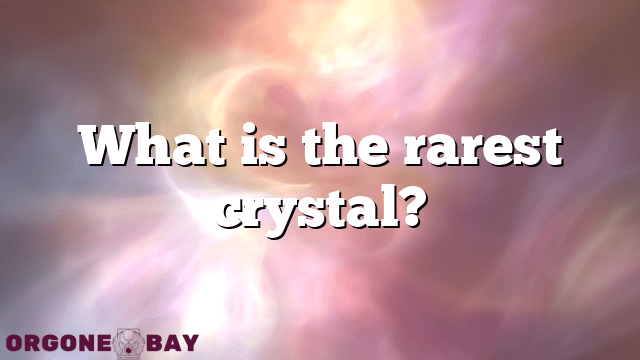Crystal Basics & Properties
What is the rarest crystal?
The rarest crystal on earth is Painite. Painite is a precious gemstone that is highly sought after by collectors and crystal enthusiasts around the world. It holds a Guinness World Record for being the rarest mineral on the planet. Its discovery in 1951 shocked the scientific community, and since then, only a handful of specimens have ever been found. In fact, there were only two known specimens of Painite for years after its discovery. Today, there are still only a limited number of Painite crystals known to exist, making it one of the most valuable and prized crystals in the world. Here are some fascinating facts about this rare crystal:
• Painite was named after Arthur Charles Davy Pain, a British gemologist who discovered the mineral in Myanmar.
• The mineral was first identified as a new species of mineral in 1956 by the British Museum of Natural History.
• Painite is composed of calcium, zirconium, boron, aluminum, and oxygen, and is usually a brownish-red or orange color.
• The crystal has a Mohs hardness of 8, which makes it one of the strongest and most durable crystals in existence.
• Painite is often found in the same deposits as rubies and sapphires, and many collectors believe it is the diamond of the mineral kingdom.
• Because Painite is so rare and valuable, many unscrupulous dealers have attempted to sell fake or synthetic specimens to unsuspecting buyers.
• To date, only a few dozen Painite crystals have ever been found, and it remains an elusive and highly prized crystal for collectors and crystal enthusiasts around the world.
Table Of Contents
Painite: The World Record Holder
When it comes to the world of gemstones and minerals, rarity and uniqueness are the ultimate prizes. And when it comes to that, Painite is the most precious gemstone in the world, holding the Guinness World Record for being the rarest mineral. With only a few dozen known specimens worldwide, acquiring a piece of Painite is a feat accomplished by only a select few elite collectors.
Painite’s Rarity and Value
Painite’s rarity is not to be taken lightly. Following its discovery in 1951, there were only two specimens of Painite over the following years. Even today, only a few dozen specimens of Painite are known to exist worldwide. The scarcity of this mineral makes it one of the most valuable gems, with prices that can go up to $60,000 per carat.
Painite’s Discovery and History
Painite was first discovered by Arthur C. D. Pain in 1951 in Myanmar. Initially, it was believed to be a new species of sapphire due to its intense red and brownish-red colors. However, upon further analysis, it was found to be a new mineral with a chemical formula of CaZrAl9O15(BO3). The mineral remained an extremely rare find for decades, and it wasn’t until the 2000s that a few more specimens of Painite were discovered.
Painite’s Physical and Chemical Properties
Painite is a hexagonal mineral that comes in a range of colors, including red, brown, orange, and pink. It has a Mohs hardness of 8, making it a durable gemstone that can withstand heavy wear and tear. Painite has a specific gravity of 4.0-4.1, which is slightly higher than diamonds. Chemically, Painite is a complex borate mineral that contains aluminum, calcium, and zirconium.
Painite: The Two Dozen Known Gemstones
Despite being one of the rarest minerals on earth, a small number of Painite specimens have made it into the hands of collectors and gemstone enthusiasts. In 2004 there were only two dozen known gemstones. The largest Painite crystal ever found weighs over 50 carats and is reportedly worth millions of dollars. Owning a piece of Painite has become a symbol of status and wealth, and its exclusivity only adds to its allure.
Painite in the Market and Collectors’ World
Because of its unprecedented rarity and value, Painite has become a highly sought-after gemstone in the market and collectors’ world. Auctions and sales featuring Painite are rare and often generate a great deal of interest and excitement. For those who can afford it, owning a Painite is an investment in a piece of history that will not only maintain its value but likely increase in value as time goes on. To the right collector or investor, a Painite could be considered priceless.

